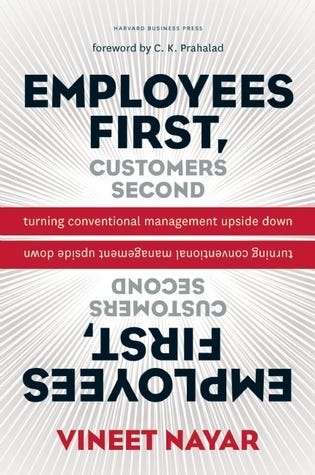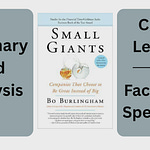Employees First, Customers Second" by Vineet Nayar details the radical management philosophy and transformation journey undertaken at HCL Technologies (HCLT) starting in 2005. Faced with a struggling legacy and intense global competition in the IT services market, Nayar inverted the traditional organizational pyramid, empowering employees at the "value zone" to drive customer satisfaction and innovation.
The core premise is that by prioritizing employees and fostering an environment of trust and transparency, companies can unlock significant value for customers and achieve remarkable growth. Nayar describes a series of "catalysts" rather than a grand plan, emphasizing that the transformation was an iterative process of self-discovery and adaptation. Key themes include:
Inverting the Organizational Pyramid: Shifting power and accountability from traditional management hierarchies to the employees who directly interact with customers and create value.
Trust Through Transparency: Building a culture of open communication, sharing financial information, and creating platforms for employees to ask questions and challenge assumptions.
Recasting the Role of the CEO: Moving from a top-down decision-maker to an enabler, a "Chief Enabling Officer," who supports and empowers employees in the value zone.
Finding Understanding in Misunderstanding: Recognizing that transformation is a continuous journey, often met with skepticism and resistance, and that overcoming these "misunderstandings" is crucial for sustained change.
The Value Zone: Identifying the point where real value is created for the customer, emphasizing that in the knowledge economy, this lies in how technology is applied and the relationships built, rather than just the technology itself.
Catalysts of Change: Understanding that transformation is often driven by small, targeted initiatives that collectively create large-scale impact.
Ant to Butterfly Transformation: A metaphor for a fundamental, qualitative shift in an organization's nature and capabilities, requiring a willingness to abandon old assumptions and acquire new knowledge.
II. Short-Answer Quiz
Instructions: Answer each question in 2-3 sentences.
What was the initial challenge HCL Technologies faced when Vineet Nayar took over in 2005, and what was the ultimate outcome after five years?
Explain the core philosophy of "Employees First, Customers Second" (EFCS). How does it differ from traditional management approaches?
Describe the "Mirror Mirror" exercise. What was its primary purpose in the initial phase of HCLT's transformation?
According to the text, why did Nayar realize there was a "missing trust quotient" among his senior managers at the Blueprint meeting?
List and briefly explain two of Maister's four dimensions of trust mentioned in the book.
How did Nayar propose to build "Trust Through Transparency" at HCLT, specifically regarding financial information and internal communication?
What is the "inverted pyramid" concept, and how does it aim to empower employees in the "value zone"?
Explain the purpose of the Smart Service Desk (SSD) and how it aimed to improve internal processes at HCLT.
What is the "Ant to Butterfly" metaphor, and what does it signify in the context of organizational transformation?
How did the successful Dixons deal exemplify the effectiveness of the EFCS concept in winning new business?
III. Short-Answer Quiz Answer Key
HCLT faced struggles to keep up with bigger rivals in a shifting IT services market, threatening its legacy of success. Five years later, under Nayar's leadership, it became one of the fastest-growing IT services partners globally, renowned for its radical management practices.
The core philosophy of EFCS is to prioritize employees, believing that empowered and trusted employees will, in turn, create greater value for customers. It differs from traditional management by inverting the hierarchical pyramid and shifting accountability downwards.
The "Mirror Mirror" exercise was designed to help HCLT define its "Point A," a clear and honest assessment of its current reality and position relative to its peers and the evolving industry landscape. It served to reveal the "truth" about the company's situation.
Nayar realized there was a "missing trust quotient" because, despite his proposals, his managers showed cautious agreement and skepticism, indicating a lack of complete trust in him and the radical new strategy. This prompted him to focus on building trust first.
Credibility: Comes from professional expertise and deep knowledge, leading others to trust what a person says and does. Reliability: Revealed through consistent actions over time, indicating dependability and that a person will do what they say. (Other options: Intimacy, Self-orientation)
Nayar proposed building trust through transparency by expanding access to financial performance information for all employees, and by creating the "U&I" portal, which allowed employees to ask questions directly to senior management.
The "inverted pyramid" concept places employees in the "value zone" (those directly creating customer value) at the top, and management and enabling functions below them. It aims to make management accountable to the value zone, empowering employees to make decisions and take responsibility.
The Smart Service Desk (SSD) was an internal system allowing employees to open tickets for problems, queries, or work requests directed to enabling functions like HR or IT. Its purpose was to resolve internal issues efficiently, transparently, and with set deadlines, improving employee satisfaction.
The "Ant to Butterfly" metaphor describes a fundamental, qualitative transformation of an organization, moving beyond incremental improvements (a "fast-walking ant"). It signifies a complete change in nature, requiring a willingness to discard old knowledge and embrace entirely new ways of thinking and operating.
The Dixons deal was a significant breakthrough because it was a much larger contract than HCLT's previous ones and represented a strategic partnership, rather than just discrete outsourced services. This success validated the EFCS approach in competing and winning against larger global players.
IV. Essay Format Questions
Analyze the role of "transparency" as a foundational element in HCLT's transformation. Discuss specific examples (e.g., sharing financial information, U&I portal) and explain how these initiatives aimed to build trust and empower employees.
Discuss how Vineet Nayar "recast the role of the CEO" at HCLT. How did his personal journey and shift from a traditional leadership mindset contribute to the success of the EFCS model?
Evaluate the significance of the "value zone" concept in "Employees First, Customers Second." How did HCLT identify and leverage this concept to differentiate itself in the IT services market, especially in the context of the evolving knowledge economy?
Nayar frequently refers to the transformation at HCLT as being driven by "catalysts" rather than a grand plan. Explain what he means by "catalysts" and provide examples from the text. Argue whether this approach is generally applicable to other organizations seeking transformation.
The book suggests that transformation often requires overcoming "misunderstandings." Discuss some of the key "yes, but" objections and skepticism Nayar encountered during HCLT's journey. How did he address these concerns, and what do these instances reveal about the challenges of radical organizational change?
V. Glossary of Key Terms
Ant to Butterfly Transformation: A metaphor used by Nayar to describe a profound, qualitative change in an organization, moving beyond incremental improvements to a fundamental shift in its nature and capabilities.
Blueprint Meeting: A three-day conference held by Nayar with HCLT's top 100 leaders to collaboratively define the company's future strategy and address its challenges.
Catalysts of Positive Change: Small, targeted actions or initiatives that, individually, may seem minor but collectively create a significant, large-scale positive impact within an organization.
Chief Enabling Officer (CEO - recast role): Nayar's redefined role for the CEO, moving from a traditional top-down authority figure to one who supports, enables, and empowers employees in the value zone.
Credibility: One of Maister's four dimensions of trust, stemming from a person's professional expertise, deep knowledge, and adherence to good practice, which instills trust in their words and actions.
EFCS (Employees First, Customers Second): The core philosophy of HCL Technologies' transformation, advocating that by prioritizing and empowering employees, a company can deliver superior value to customers.
Enabling Functions: Internal departments (e.g., HR, Finance, IT) that support the "value zone" employees. Under EFCS, these functions become accountable to the employees they serve.
Gen Y (Transformers): A term used in the book to refer to a generation of employees who are naturally adept at dealing with rapid change and embody the new knowledge economy's value drivers.
Inverted Organizational Pyramid: A management structure proposed by Nayar where the traditional hierarchy is flipped, placing employees at the "value zone" at the top and senior management at the bottom, making leaders accountable to front-line employees.
Intimacy: One of Maister's four dimensions of trust, referring to the emotional connection and comfort one feels discussing various issues with a person.
Knowledge Economy: An economic system where value is primarily derived from knowledge, information, and intellectual assets, rather than traditional physical goods or labor.
Maister's Dimensions of Trust: A framework for understanding trust, comprising four elements: credibility, reliability, intimacy, and self-orientation.
Mirror Mirror Exercise: An initial diagnostic process at HCLT aimed at honestly assessing the company's current reality ("Point A") by gathering candid feedback from employees about the organization's strengths, weaknesses, and market position.
Point A: In Nayar's framework for change, this refers to a clear and honest definition of an organization's current situation, including its performance, market position, and internal realities.
Point B: In Nayar's framework for change, this refers to the desired future state or strategic goals an organization aims to achieve.
Reliability: One of Maister's four dimensions of trust, demonstrated through consistent actions over time, indicating dependability and that a person will fulfill their commitments.
Reverse Accountability: A concept where traditional accountability is flipped, meaning that managers and enabling functions are accountable to the employees they support, particularly those in the value zone.
Self-orientation: One of Maister's four dimensions of trust, where a high degree of self-interest reduces trust. Conversely, trust is built when one believes another person acts beyond their personal gain.
Smart Service Desk (SSD): An internal IT-based system implemented at HCLT, allowing employees to log tickets for problems, queries, or requests to various enabling functions, ensuring transparent tracking and timely resolution.
Trust Quotient: A measure of the level of trust perceived by others in an individual or organization, often considered to be lower than one might assume in a large organization.
U&I Portal: An internal online platform at HCLT designed for "Trust Through Transparency," allowing employees to directly ask questions to any senior manager, including the CEO, with responses visible to all.
Value Zone: The specific area or interaction point where a company directly creates value for its customers. In the knowledge economy, Nayar argues this often shifts from technology itself to the application and relationship aspects.
"Yes, But" Managers: A group of managers identified by Nayar who, despite understanding new ideas, consistently raise objections and focus on potential problems rather than solutions.















Share this post